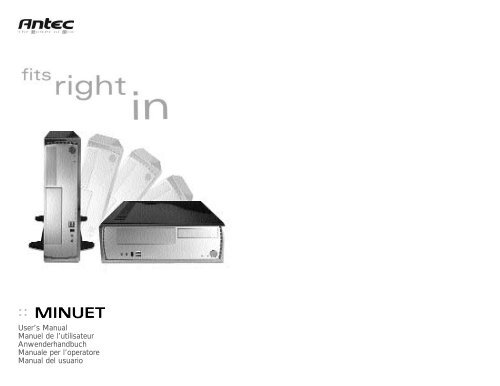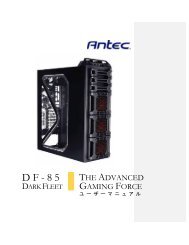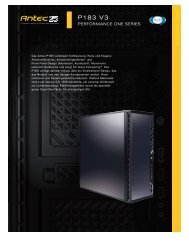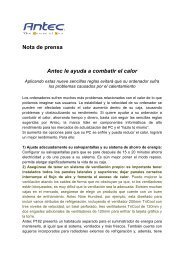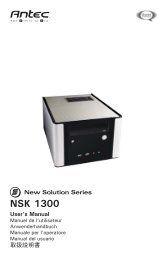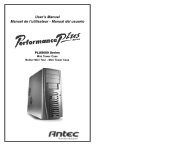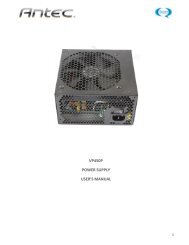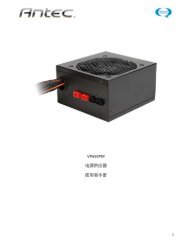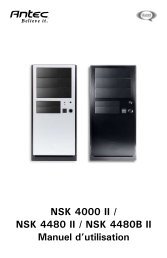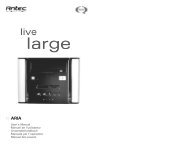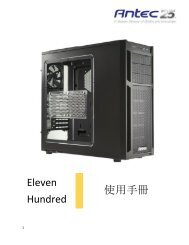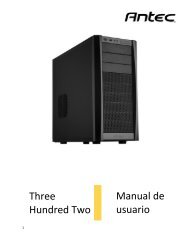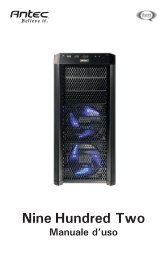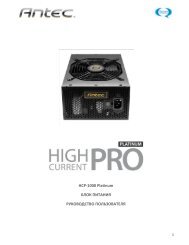User's Manual Manuel de l'utilisateur Anwenderhandbuch ... - Antec
User's Manual Manuel de l'utilisateur Anwenderhandbuch ... - Antec
User's Manual Manuel de l'utilisateur Anwenderhandbuch ... - Antec
Create successful ePaper yourself
Turn your PDF publications into a flip-book with our unique Google optimized e-Paper software.
User’s <strong>Manual</strong><br />
<strong>Manuel</strong> <strong>de</strong> l’utilisateur<br />
Anwen<strong>de</strong>rhandbuch<br />
<strong>Manual</strong>e per l’operatore<br />
<strong>Manual</strong> <strong>de</strong>l usuario
The high quality of our products is assured by a continuous process of refinement<br />
of their technical features. Therefore, it is possible that your product may differ<br />
in some respect from the <strong>de</strong>scriptions contained in this manual. This is not a<br />
problem– it is an improvement. All features, <strong>de</strong>scriptions and illustrations<br />
contained herein are valid as of the date of publication.<br />
Disclaimer<br />
This manual is inten<strong>de</strong>d only as a gui<strong>de</strong> for <strong>Antec</strong>'s Computer Enclosures. For more comprehensive<br />
instructions on installing your motherboard and peripherals, please refer to the user's manuals<br />
which come with your components and drives.<br />
MINUET User’s <strong>Manual</strong><br />
Set Up<br />
1. Take the case out of the box. Remove the Styrofoam and the plastic bag.<br />
2. Place the case on a flat surface.<br />
3. Remove the thumbscrews from the top panel (at the rear of the case). Sli<strong>de</strong><br />
the panel to the rear of the case and remove it. Set the panel safely asi<strong>de</strong>.<br />
Note: Please don't try to use your fingernails to pry or lift the panel.<br />
4. Insi<strong>de</strong> the case you should see the power supply, some wiring with marked<br />
connectors (USB, PWR etc.), an installed I/O panel and a power cord. You<br />
will also find a bag of screws, four rubber feet and two plastic stands.<br />
Note: The plastic stands allow you to orient the Minuet in two positions –<br />
horizontal and vertical.<br />
5. Horizontal Orientation: stick the four adhesive rubber feet to the bottom<br />
panel of the case to protect the paint from scratches.<br />
6. Vertical Orientation: place the Minuet in the two plastic stands, adjust<br />
the stands to fit snugly against the case si<strong>de</strong>s.<br />
[Applicable only to mo<strong>de</strong>ls <strong>de</strong>signed for sale in the European Union: All <strong>Antec</strong><br />
power supplies <strong>de</strong>signed for the EU inclu<strong>de</strong> a Power Factor Correction (PFC)<br />
circuitry in accord with European standard regulation co<strong>de</strong> EN61000-3-2. By<br />
altering the input current wave shape, PFC improves the power factor of the<br />
power supply and results in increased energy efficiency, reduced heat loss,<br />
prolonged life for power distribution and consumption equipment, and improved<br />
output voltage stability.]<br />
Motherboard Installation<br />
This manual is not <strong>de</strong>signed to cover CPU, RAM, or expansion card installation.<br />
Please consult your motherboard manual for specific mounting instructions and<br />
troubleshooting.<br />
1. Make sure you have the appropriate I/O panel for your motherboard. If the<br />
standard panel provi<strong>de</strong>d with Minuet is not suitable for your motherboard,<br />
please contact your motherboard manufacturer for the correct I/O panel.<br />
2. Line up your motherboard with the standoff holes, and <strong>de</strong>termine which<br />
ones line up and remember where they are. Not all motherboards will<br />
match with all of the provi<strong>de</strong>d screw holes, and this is not necessary for<br />
proper functionality. (In other words there will likely be extra holes.) Some<br />
standoffs may be pre-installed for your convenience.<br />
3. Lift up and remove your motherboard.<br />
4. Screw in the brass standoffs to the threa<strong>de</strong>d holes that line up with your<br />
motherboard's mounting holes.<br />
5. Place your motherboard on the brass standoffs.<br />
6. Mount your motherboard on the standoffs with the provi<strong>de</strong>d Phillips-head<br />
screws. Your motherboard is now installed.<br />
Power/LED Connections<br />
The power supply is an ATX12V form factor power supply. It has a single 20 pin<br />
Main Power Connector and a 4-pin +12V Power Connector to connect to the<br />
motherboard. It also comes with three 4-pin Peripheral Power Connectors and<br />
one 4-pin Floppy Drive Power Connector for your drives. It is backwards compatible<br />
to previous ATX form factor power supplies. If your motherboard does not<br />
support the +12V Power Connector, you can still use this power supply.<br />
1. Connect the 20-pin ATX power connector (and +12V connector if<br />
appropriate) to your motherboard.<br />
2. Power Switch (labeled POWER SW) connects to the PWR connector on the<br />
motherboard.<br />
3. Attach the Speaker (labeled SPEAKER), Power LED (labeled P LED) and<br />
HDD LED connectors to the appropriate hea<strong>de</strong>rs on your motherboard.<br />
USB Connection<br />
There are 8 wires with connectors coming from the front-mounted USB ports.<br />
1. Locate the internal USB hea<strong>de</strong>r on your motherboard. It consists of 10 pins<br />
in two rows. Note: On some motherboards one or two pins may be marked<br />
as NC. This indicates no contact. It is an empty pin. You don't need to use<br />
it. On some motherboards one pin may be missing on either one or both<br />
rows. Don't worry about it. You only need to connect to 8 pins.<br />
2. Consult your motherboard manual to get each of the pin-out positions.<br />
3. Power Pins: There are two power pins, one on each row. They are usually<br />
marked as Power, Vcc or +5V. Connect the two +5V connectors to the<br />
two power pins. Each connector can go to either pin.<br />
4. Ground Pins: There are two ground pins, one on each row. They are usually<br />
marked as GROUND or GND. Connect the two GROUND connectors to the<br />
two ground pins. Each connector can go to either pin.<br />
Note: On some motherboards, there may be two ground pins on one row.<br />
You don't need to use all of them. Make sure to connect one ground pin<br />
on each row.<br />
5. Data Pins: There are two plus data pins, one on each row, and two minus<br />
data pins, one on each row. They are usually marked as USBD2+, USBD3+<br />
and USBD2-, USBD3- or USBP2+, USBP3+ and USBP2-, USBP3- respectively.<br />
a. Connect the (1)+D connector to any of the two plus data pins. It can<br />
go to either of the plus pins.<br />
b. Connect the (1)- D connector to the minus data pin in the same row as<br />
the plus data pin (1)+D connector.<br />
c. Repeat the same procedures to connect the (2)+D and (2)-D to the<br />
motherboard. Make sure they are in the same row.<br />
1<br />
2
IEEE 1394 (FireWire, i.Link) Connection<br />
There are six wires with connectors coming from the front-mounted IEEE 1394<br />
port of your case. They consist of a power cable (VP), a ground cable (VG),<br />
and two sets of twisted pair cables: TPA (Twisted Pair A) and TPB (Twisted<br />
Pair B).<br />
1. Locate and and i<strong>de</strong>ntify the pin-out of the IEEE1394 port on your<br />
motherboard.<br />
2. Power Pin: Connect the VP connector to it.<br />
3. Ground Pin: Connect the VG connector to it.<br />
4. Data Pins: There are two sets of data pins. Each set consists of a plus and<br />
a minus pin. They are usually marked as TPA+ and TPA-, TPB+ and TPB-.<br />
a. Connect the TPA+ connector to the TPA+ data pin and TPAconnector<br />
to the TPA- data pin.<br />
b. Connect the TPB+ connector to the TPB+ data pin and TPBconnector<br />
to the TPB- data pin.<br />
Audio Connection<br />
The audio connectors connect to the motherboard through a five-wire ribbon cable.<br />
1. Locate the internal audio connectors from your motherboard or sound card.<br />
They are usually two rows of hea<strong>de</strong>rs with either 3 or 4 pins per row,<br />
marked Speaker and Microphone.<br />
2. Consult your motherboard or sound card manual for the pin-out positions.<br />
3. Microphone Power Pin: Connect the MIC-PWR connector to this pin.<br />
4. Microphone Input Pin: Connect the MIC-IN connector to this pin.<br />
5. Ground Pin: Connect the GROUND connector to this pin.<br />
6. Front right Speaker Out Pin: Connect the R-OUT connector to this pin.<br />
7. Front left Speaker Out Pin: Connect the L-OUT connector to this pin.<br />
8. Rear right Speaker Out Pin: Connect the R-RET connector to this pin.<br />
9. Rear left Speaker Out Pin: Connect the L-RET connector to this pin.<br />
Note: If your motherboard is not equipped with REAR SPEAKER output, it is not<br />
necessary to use the R-RET and L-RET connectors.<br />
Drive Installation<br />
Minuet incorporates a rapid-release Flip Up Drive Cage for<br />
easy drive installation. The Cage inclu<strong>de</strong>s three drive<br />
bays: one external 5.25", one external 3.5", and one<br />
internal 3.5".<br />
1. Before installing the external drives, remove the<br />
external drive bay covers.<br />
a. To remove the external 5.25" drive bay cover,<br />
with the case facing you, use your left hand<br />
thumb to press firmly on the LEFT or outsi<strong>de</strong><br />
edge of the left bay cover to release it.<br />
(See Photo 1)<br />
b. To remove the external 3.5" drive bay cover,<br />
with the case facing you, use your right hand<br />
thumb to press firmly on the RIGHT or outsi<strong>de</strong><br />
Photo 1<br />
Photo 2<br />
edge of the right bay cover to release it.<br />
(See Photo 2)<br />
2. Lift and sli<strong>de</strong> out the Cage from the case.<br />
3. Place the Cage upsi<strong>de</strong> down on a flat surface.<br />
4. Note: You must install the external <strong>de</strong>vices first,<br />
before installing the internal 3.5" <strong>de</strong>vice.<br />
5. Sli<strong>de</strong> the external 5.25" <strong>de</strong>vice into the drive bay<br />
from the front of the cage.<br />
6. Align the bottom rear screw holes (one at each<br />
si<strong>de</strong>) on the <strong>de</strong>vice with the two screw holes (the<br />
pair closest to the front of the cage) on the cage<br />
and fasten the <strong>de</strong>vice with the screws provi<strong>de</strong>d.<br />
(See Photo 3)<br />
7. Sli<strong>de</strong> the external 3.5" <strong>de</strong>vice into the drive bay<br />
from the front of the Cage.<br />
8. Align the bottom rear screw holes (one at each<br />
si<strong>de</strong>) on the <strong>de</strong>vice with the two screw holes on<br />
the cage and fasten the <strong>de</strong>vice with the screws<br />
provi<strong>de</strong>d. (See Photo 4)<br />
9. To install the internal 3.5" <strong>de</strong>vice, find the two<br />
mounting prongs on one si<strong>de</strong> of the bay. With one<br />
hand holding the <strong>de</strong>vice at a 45-<strong>de</strong>gree angle with<br />
the bottom si<strong>de</strong> up, align the two screw holes on<br />
one si<strong>de</strong> of the <strong>de</strong>vice with the prongs and sli<strong>de</strong><br />
the <strong>de</strong>vice into the bay. (See Photo 5)<br />
10. Fasten the other si<strong>de</strong> of the <strong>de</strong>vice to the two tabs<br />
with the screws provi<strong>de</strong>d. (See Photos 6)<br />
11. Connect power to each of the <strong>de</strong>vices.<br />
12. When sliding the Cage back into the case, work<br />
slowly and carefully to ensure that the front panels<br />
of the external <strong>de</strong>vices align properly with the holes<br />
provi<strong>de</strong>d for them in the bezel.<br />
Photo 3<br />
Photo 4<br />
Photo 5<br />
Photo 6<br />
Data Cable Connection<br />
After you have connected the <strong>de</strong>vices to the power supply, you need to connect<br />
the data cables between the <strong>de</strong>vices and the motherboard. The data cables are<br />
not inclu<strong>de</strong>d with the case; we inclu<strong>de</strong> this information only as an aid.<br />
1. For hard drives and CD-ROM's, use 40-pin IDE ribbon cables. For floppy<br />
drives, use a 34-pin ribbon cable. These should come with your motherboard<br />
or <strong>de</strong>vices and have a red strip on one si<strong>de</strong> indicating pin number 1. When<br />
you connect a ribbon cable to a <strong>de</strong>vice, make sure that the red strip is on<br />
pin 1, usually toward the power connector.<br />
2. The end of an IDE or Floppy ribbon cable that attaches to your <strong>de</strong>vice<br />
frequently has 2 connectors. This enables you to connect another <strong>de</strong>vice if<br />
you wish. When connecting a cable to a <strong>de</strong>vice, be careful to avoid bending<br />
any pins or misaligning the connector on the hea<strong>de</strong>r.<br />
3. Connect the far end of the cable to your motherboard on the IDE port,<br />
either IDE 1 or IDE 2, or on the FLOPPY port. Again, when connecting a<br />
cable to your motherboard, be careful to avoid bending any pins or<br />
misaligning the connector on the hea<strong>de</strong>r.<br />
3 4
Fan Installation<br />
Minuet has a mounting location for an optional 40mm fan in the rear of the<br />
case, above the I/O panel. For maximum ventilation, the rear fan should be<br />
installed so that the air is exhausting from the case. Align the mounting holes in<br />
the fan with the two mounting prongs provi<strong>de</strong>d, and attach the fan with screws<br />
through the two mounting screw holes provi<strong>de</strong>d. Connect a regular 4-pin Molex<br />
connector from the power supply to the connector on the fan.<br />
<strong>Antec</strong> Quality 3-Year parts and labor warranty (A3Q)<br />
See <strong>de</strong>tails at: http://www.antec-inc.com/warranty.html<br />
5<br />
6
MINUET<br />
Piano Black Slimline PC Case<br />
Drawing<br />
Description<br />
Number<br />
1 Thumbscrews<br />
2 Top Panel<br />
3 Power Supply<br />
4 Flip Up Drive Cage<br />
5 Power Switch/Cable<br />
6 Power LED/Cable<br />
7 HD LED/Cable<br />
8 3.5” Drive Bay Cover<br />
9 Front Bezel<br />
10 5.25” Drive Bay Cover<br />
11 Front Port Assembly<br />
12<br />
13<br />
14<br />
Case<br />
Expansion Slot Covers<br />
I/O Panel


